
The Channel Islands are an eight-island archipelago located within the Southern California Bight in the Pacific Ocean, off the coast of California. The four Northern Channel Islands are part of the Transverse Ranges geologic province, and the four Southern Channel Islands are part of the Peninsular Ranges province. Five of the islands are within the Channel Islands National Park, and the waters surrounding these islands make up Channel Islands National Marine Sanctuary. The islands were first colonized as early as 13,000 years ago, the earliest paleontological evidence of humans in North America. They are the easternmost islands in the Pacific Island group.

Tube-dwelling anemones or ceriantharians look very similar to sea anemones but belong to an entirely different subclass of anthozoans. They are solitary, living buried in soft sediments. Tube anemones live inside and can withdraw into tubes, which are composed of a fibrous material made from secreted mucus and threads of nematocyst-like organelles known as ptychocysts. Within the tubes of these ceriantharians, more than one polyp is present, which is an exceptional trait because species that create tube systems usually contain only one polyp per tube. Ceriantharians were formerly classified in the taxon Ceriantipatharia along with the black corals but have since been moved to their own subclass, Ceriantharia.

Hermissenda crassicornis, also known as the thick-horned nudibranch, is a species of brightly coloured, sea slug or nudibranch, a marine gastropod mollusc in the family Facelinidae.
Calexcitin is a calcium-binding protein first isolated from the sea snail Hermissenda crassicornis. It is upregulated following Pavlovian conditioning.
Aquadulcaris is a genus of crustaceans in the family Paramelitidae, containing the following species:
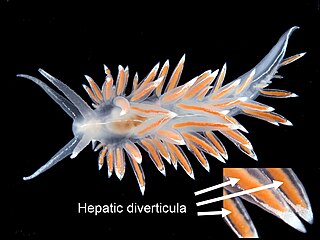
As applied to mollusks, the New Latin term diverticulum is an anatomical feature. The term is most often encountered in the plural form as "diverticula", "hepatic diverticula", or "digestive diverticula", which are anatomical terms for organs which are visible from the outside of the body in a clade of sea slugs known as aeolid nudibranchs, marine opisthobranch gastropod molluscs.
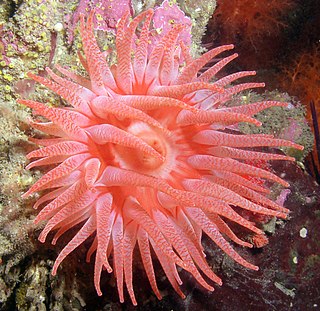
Cribrinopsis fernaldi, also known as the crimson anemone, snakelock anemone, chevron-tentacle anemone and Fernald brooding anemone, is a sea anemone native to the Pacific Ocean off northwestern North America.

Phidiana hiltoni is a species of sea slug, an aeolid nudibranch, a shell-less marine gastropod mollusc in the family Facelinidae.

Urticina crassicornis, commonly known as the mottled anemone, the painted anemone or the Christmas anemone, is a large and common intertidal and subtidal sea anemone. Its habitat includes a large portion of the coastal areas of the northern hemisphere, mainly polar regions, and it lives a solitary life for up to 80 years. Mottled anemones are similar to Dahlia anemones and both are commonly referred to as northern red anemones.

The Facelinidae are a taxonomic family of colorful sea slugs. These are specifically aeolid nudibranchs. They are marine gastropod molluscs.
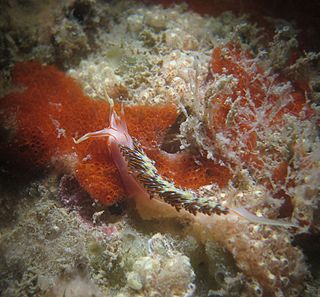
Phidiana is a genus of sea slugs, aeolid nudibranchs, marine gastropod molluscs in the family Facelinidae.

Urticina is a genus of relatively large and often colorful sea anemones in the family Actiniidae from the North Pacific, North Atlantic and Arctic Oceans.
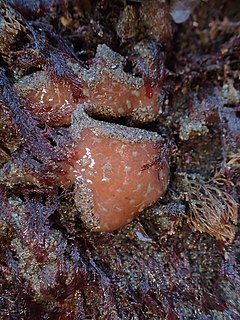
Aplidium solidum is a species of colonial sea squirts, a tunicate in the family Polyclinidae. It is commonly known as the red ascidian or sea pork.
Sphecodes crassicornis is a species of bee in the genus Sphecodes, of the family Halictidae.
Charles Henry O'Donoghue FRSE FZS was an English zoologist who studied molluscs, a malacologist. His publications mostly deal with sea slugs and he also named a number of Bryozoans. A collection of over 700 items left to the University of Reading is known as the O'Donoghue Collection.
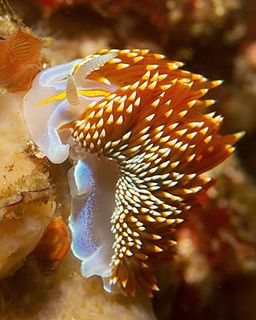
Hermissenda opalescens is a species of brightly coloured sea slug or nudibranch, a marine gastropod mollusc in the family Facelinidae.
Hermissenda emurai is a species of brightly coloured sea slug or nudibranch, a marine gastropod mollusc in the family Facelinidae.
The opalescent nudibranch or opalescent sea slug may refer to:

Actinostola is a genus of sea anemones in the order Actiniaria. Members of this genus are deep sea species, with some occurring at hydrothermal vents.

Bispira is a genus of marine bristleworm in the family Sabellidae. Its members were initially included in genus Sabella by Grube in 1851. In 1856, Krøyer described Bispira as a separate genus. Members of Bispira are defined by spirally-coiled, equally-divided branchial lobes.














